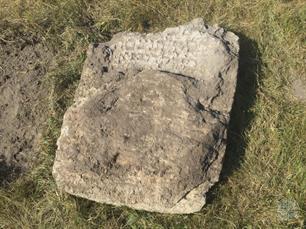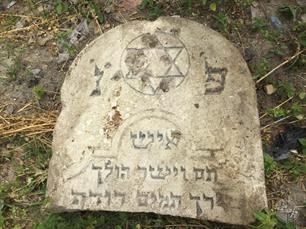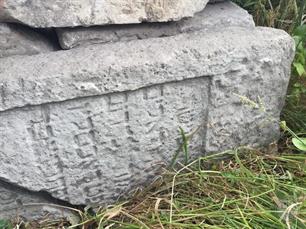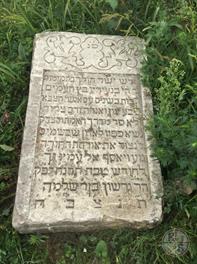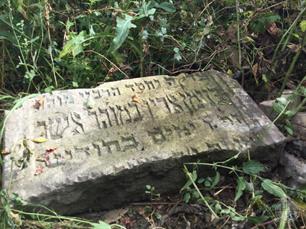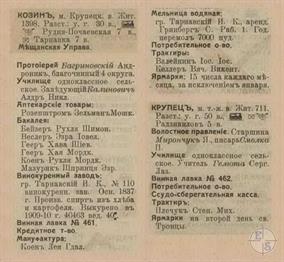Kozyn
Dubno district, Rivne region
Sources:
- Jewish encyclopedia of Brockhaus & Efron;
- Russian Jewish encyclopedia. Translated from Russian by Eugene Snaider;
- The All South-Western Territory: reference and address book of the Kyiv, Podolsk and Volyn provinces. Printing house L.M. Fish and P.E. Wolfson, 1913;
- Yad Vashem. Kozin
Photo:
- European Jewish Cemeteries Initiative. Kozyn Jewish Cemetery
- Jewish encyclopedia of Brockhaus & Efron;
- Russian Jewish encyclopedia. Translated from Russian by Eugene Snaider;
- The All South-Western Territory: reference and address book of the Kyiv, Podolsk and Volyn provinces. Printing house L.M. Fish and P.E. Wolfson, 1913;
- Yad Vashem. Kozin
Photo:
- European Jewish Cemeteries Initiative. Kozyn Jewish Cemetery
Kozyn (ukr. Козин) was founded in the 16th century. In the 16–18 centuries - the township of Lutsk powiat of the Volyn Voivodeship as part of the Commonwealth. Since 1795 - as part of the Russian Empire. In the 19th - beginning of the 20th century - the township of Dubno district of the Volyn province.
In 1919–39 - in the Volyn Voivodeship as part of Poland, in 1939–91 - as part of the Ukrainian SSR.
In 1765, 332 Jews lived in Kozyn,
in 1847 - 495,
in 1897 - 972 (53.4%),
In 1921 - 525 Jews (51.4%).
Jewish settlement in Kozin dates from the mid-16th century.
In the 19th - early 20th centuries Jews made their living from small trade and crafts.
In 1583 in Kozyn there were 5 Jewish craftsmen of 10.
In 1652, the Jewish community was defeated by the Tatars who had attacking Kozyn; after the pogrom, 2 houses belonging to the Jews were preserved.
In 1837, a winery and a mill were opened, which were leased by Jews.
In 1865 there was a synagogue.
In 1914, the Jews owned a pharmacy, 7 grocery and manufactory shops.
The Jew S. Grinberg rented a mill.
In 1919–39 - in the Volyn Voivodeship as part of Poland, in 1939–91 - as part of the Ukrainian SSR.
In 1765, 332 Jews lived in Kozyn,
in 1847 - 495,
in 1897 - 972 (53.4%),
In 1921 - 525 Jews (51.4%).
Jewish settlement in Kozin dates from the mid-16th century.
In the 19th - early 20th centuries Jews made their living from small trade and crafts.
In 1583 in Kozyn there were 5 Jewish craftsmen of 10.
In 1652, the Jewish community was defeated by the Tatars who had attacking Kozyn; after the pogrom, 2 houses belonging to the Jews were preserved.
In 1837, a winery and a mill were opened, which were leased by Jews.
In 1865 there was a synagogue.
In 1914, the Jews owned a pharmacy, 7 grocery and manufactory shops.
The Jew S. Grinberg rented a mill.
On July 17, 1919, a pogrom occurred in Kozyn, arranged by the gang of Ataman Zelenyy, on August 24, 1919 another pogrom was made.
The Jews of Kozin traded in agricultural produce and were petty merchants and artisans. Several Zionist parties (HaMizrahi and others) and youth movements (Beitar and HeHalutz) were active in the town, and a Talmud Torah operated there.
The Germans occupied Kozyn on June 24, 1941. A few days later, they ordered all the town's Jewish men to assemble, and local Ukrainians identified those whom they considered Soviet activists. These men were then shot dead. A few weeks later, the Germans set fire to the synagogue and its Torah scrolls, and twenty Jews were murdered.
In the summer and fall of 1941, the Germans introduced a series of anti-Jewish measures in Kozyn: Jews were required to wear armbands with the Star of David (replaced later with a yellow circular patch); they had to perform forced labor with little or no compensation, and they were forbidden to leave the town's limits.
In late May 1942, the German authorities established a ghetto in Kozyn, which housed Jews from the town itself and from the surrounding villages. Eight days later, following a selection in which the skilled workers and their families had been singled out and allowed to remain in the ghetto, about 400 Jews were killed by a German unit in the nearby village of Hranуwka, just southeast of Kozin.
Some Jews avoided this murder operation by hiding in the ghetto. Once the operation was over, many of those who had hidden outside the ghetto returned to the ghetto, under the illusion that those who were working would not be killed.
In early October 1942, the Kozyn Ghetto was liquidated, and its remaining inmates were killed by German units outside the town, near the same village of Granivka. On the eve of this murder operation, several dozen Jews succeeded in escaping from the ghetto, but many of them were subsequently caught by the Ukrainian auxiliary police and shot dead.
The Jews of Kozin traded in agricultural produce and were petty merchants and artisans. Several Zionist parties (HaMizrahi and others) and youth movements (Beitar and HeHalutz) were active in the town, and a Talmud Torah operated there.
The Germans occupied Kozyn on June 24, 1941. A few days later, they ordered all the town's Jewish men to assemble, and local Ukrainians identified those whom they considered Soviet activists. These men were then shot dead. A few weeks later, the Germans set fire to the synagogue and its Torah scrolls, and twenty Jews were murdered.
In the summer and fall of 1941, the Germans introduced a series of anti-Jewish measures in Kozyn: Jews were required to wear armbands with the Star of David (replaced later with a yellow circular patch); they had to perform forced labor with little or no compensation, and they were forbidden to leave the town's limits.
In late May 1942, the German authorities established a ghetto in Kozyn, which housed Jews from the town itself and from the surrounding villages. Eight days later, following a selection in which the skilled workers and their families had been singled out and allowed to remain in the ghetto, about 400 Jews were killed by a German unit in the nearby village of Hranуwka, just southeast of Kozin.
Some Jews avoided this murder operation by hiding in the ghetto. Once the operation was over, many of those who had hidden outside the ghetto returned to the ghetto, under the illusion that those who were working would not be killed.
In early October 1942, the Kozyn Ghetto was liquidated, and its remaining inmates were killed by German units outside the town, near the same village of Granivka. On the eve of this murder operation, several dozen Jews succeeded in escaping from the ghetto, but many of them were subsequently caught by the Ukrainian auxiliary police and shot dead.

- Home
- Shtetls
- Vinnytsia region
- Volyn region
- Dnipro region
- Donetsk region
- Zhytomyr region
- Zakarpattia region
- Zaporizhzhia region
- Ivano-Frankivsk region
- Kyiv region
- Kropyvnytskyi region
- Luhansk region
- Lviv region
- Mykolayiv region
- Odessa region
- Poltava region
- Rivne region
- Sumy region
- Ternopil region
- Kharkiv region
- Kherson region
- Khmelnytskyi region
- Chernihiv region
- Chernivtsi region
- Cherkasy region
- Crimea
- Synagogues
- Cemeteries
- Objects & guides
- Old photos
- History
- Contact
Jewish towns of Ukraine
My shtetl
My shtetl
Donate
Jewish towns of Ukraine

